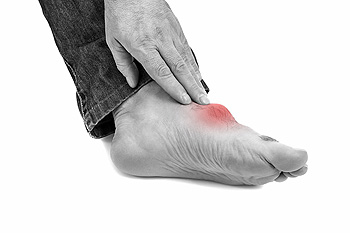 A protruding bone on the side of the big toe may be referred to as a bunion. It generally causes discomfort, and this may affect the type of shoes that are worn. This condition occurs as a result of an enlargement of the joint at the bottom of the big toe. Consequently, this may cause the big toe to lean toward the other toes, and a bony lump may appear on the side of the big toe. There may be several noticeable symptoms associated with bunions, including pain and discomfort, redness, and tenderness. Arthritis may develop if this condition is not treated properly, and it may be difficult to wear specific types of shoes. Research has indicated that bunions may be caused by genetic traits, which may include flat feet, or abnormal foot structures. Additionally, wearing high heels that have inadequate room in the toe area may cause bunions to form. If you are afflicted with a bunion, it is suggested to speak with a podiatrist who can properly treat this condition.
A protruding bone on the side of the big toe may be referred to as a bunion. It generally causes discomfort, and this may affect the type of shoes that are worn. This condition occurs as a result of an enlargement of the joint at the bottom of the big toe. Consequently, this may cause the big toe to lean toward the other toes, and a bony lump may appear on the side of the big toe. There may be several noticeable symptoms associated with bunions, including pain and discomfort, redness, and tenderness. Arthritis may develop if this condition is not treated properly, and it may be difficult to wear specific types of shoes. Research has indicated that bunions may be caused by genetic traits, which may include flat feet, or abnormal foot structures. Additionally, wearing high heels that have inadequate room in the toe area may cause bunions to form. If you are afflicted with a bunion, it is suggested to speak with a podiatrist who can properly treat this condition.
If you are suffering from bunion pain, contact one of our podiatrists of Family Foot and Ankle Care of Moriches. Our doctors can provide the care you need to keep you pain-free and on your feet.
What Is a Bunion?
Bunions are painful bony bumps that usually develop on the inside of the foot at the joint of the big toe. As the deformity increases over time, it may become painful to walk and wear shoes. Women are more likely to exacerbate existing bunions since they often wear tight, narrow shoes that shift their toes together. Bunion pain can be relieved by wearing wider shoes with enough room for the toes.
Causes
- Genetics – some people inherit feet that are more prone to bunion development
- Inflammatory Conditions - rheumatoid arthritis and polio may cause bunion development
Symptoms
- Redness and inflammation
- Pain and tenderness
- Callus or corns on the bump
- Restricted motion in the big toe
In order to diagnose your bunion, your podiatrist may ask about your medical history, symptoms, and general health. Your doctor might also order an x-ray to take a closer look at your feet. Nonsurgical treatment options include orthotics, padding, icing, changes in footwear, and medication. If nonsurgical treatments don’t alleviate your bunion pain, surgery may be necessary.
If you have any questions, please feel free to contact our offices located in Moriches and Shirley, NY . We offer the newest diagnostic and treatment technologies for all your foot care needs.



